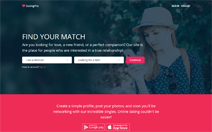Advertising Dating Site: User Data Tracking And What Events To Monitor First
![]()
Continuing our latest Advertising Dating Site guide, we started with general tips about what’s Google Ads, two types of ad networks and what are the most common mistakes entrepreneurs do.
And today we continue with one of the most important settings you need to do before starting advertising your own dating site or dating app – setting up analytics. The current state of advertisement systems works in such a way, that running an ad campaign without proper tracking will end only in a futile loss of your money.
We’ll start with the basics first to make sure we are all on the same level.
Contact our Expert team if you want to hire us and outsource your bothersome work to the experts!
If you are a customer-oriented business, like we are, then one of your main prerogatives is to understand customer problems, as well as to collect insights about how they use your service and when they get the most value from it.
Therefore, one of the most important stages of working with a product (a service, site or mobile app) is collecting user data.
Analyzing user actions allows us to improve indicators of user engagement, churn rate, conversion, as well as adjust communication and increase revenue.
Today we’ll talk about what are the events in terms of analytics, why they should be analyzed, and what user data can be collected. A detailed guide to the selection of events will be published very soon in the second part of this material.
![]()
What is ‘event’?
All user data is built on events. Events are actions or steps that a user performs inside your service. An event can be: opening the app, registering, creating an account, watching a video, adding a product to a shopping cart, uploading a photo, etc.
You have full freedom to decide what data to track in analytics systems. If there is too much data, it will be difficult for you to analyze it qualitatively and vice versa – the analytics of one or two events is useless: you cannot determine how the service works, how users are involved in it and configure the correct communication with them.
Why we analyze the events
There are several problems that you may encounter after launching a site or app:
- there are bugs in the product;
- users are not involved in new features;
- users have difficulties with the app/site;
- some of the features are not popular with users;
- nobody uses your product at all.
This list can continue on and on. Most importantly, you will not find out about any of the problems without properly configured data tracking.
Gathering all of the necessary events is one of the most important steps on the way to understanding how your users are involved in the service.
![]()
Difference between mobile and web data tracking
Previously, companies separated data tracking in mobile apps and on websites. But current modern platforms track users in both mobile and desktop devices.
You can receive fused user data from the mobile phone and the web, which allows you to know what they did in the application and on the site.
The difference in screens sizes between devices leads to small differences in data collection. The mobile screen is much smaller and users perform actions by tapping, swiping, and holding screen elements. As a result, mobile apps usually have fewer options in terms of navigation.
On the computer, users have significantly bigger screens and actions are performed using clicks, double-clicks, and keyboard keys. Web analytics typically includes more interactions, content, and page links.
How data collection works
The analytics system, on your site and app, tracks unique users: what they did, where they went, and their demographic data (geolocation, language, system version, etc).
Every time an action occurs in your service, the analytics system records this data. People across all online businesses track these actions:
- page visits;
- button clicks;
- filling in the fields/forms;
- interaction with messages (reading, answering);
- attempts to leave the site.
P.S. Feel free to contact our Expert team to find out more and add necessary tracking events for any analytics systems.
P.S. kudos to carrotquest for the material.




